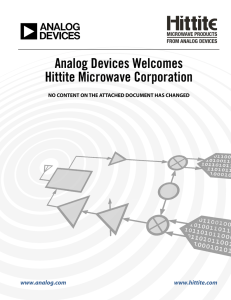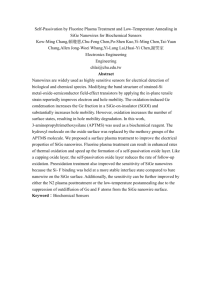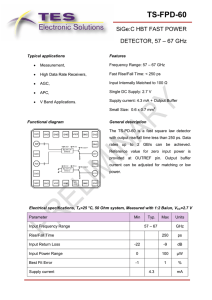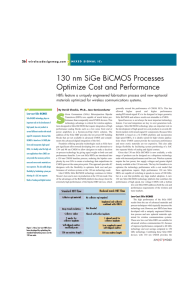TowerJazz High Performance SiGe BiCMOS processes
advertisement
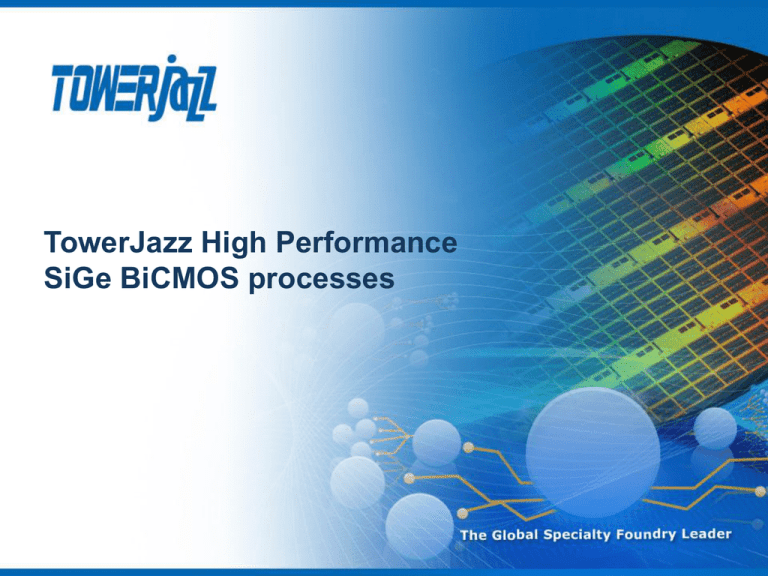
TowerJazz High Performance SiGe BiCMOS processes 2 Comprehensive Technology Portfolio 0.50 µm 0.35 µm 0.25 µm 0.18/0.16/0.152 µm 0.13 0.13µm µm BiCMOS, SiGe SiGe SiGe SiGe Power/BCD BCD BCD Power/BCD Image Sensor Image Sensor (X-Ray & Visible) (X-Ray & Visible) Image Sensor (X-Ray & Visible) eNVM Mixed-Signal Digital CMOS eNVM RFCMOS RFCMOS and SOI CMOS RFCMOS and SOI CMOS Mixed-Signal Digital CMOS Mixed-Signal Digital CMOS Mixed-Signal Digital CMOS 3 RFCMOS and SOI CMOS Mixed-Signal Digital CMOS RF and HPA Applications and Technology RF and Tuners Front-End Modules RF CMOS and SiGe BiCMOS Cell Phone, WiFi TxRx Basestation, Specialty Wireless TV, Satellite, STB Tuners SOI Switch and SiGe Power Amplifiers Power Amplifiers Antenna Switch PA Controllers mmWave High Performance Analog High Performance SiGe Optical Fiber Networks Automotive Radar 60 GHz WiFi, 24GHz Backhaul Light Peak and Thunderbolt GPS LNA Complementary BiCMOS Line Drivers DSL, HomePlug, ATE HDD PreAmp DAC, ADC Best-in-class SiGe, RF CMOS, RF models and Design Enablement 4 4 Front-End Module Technology Controller SOI Switch RF CMOS Controller Platform 5V, 0.18um optimized CMOS Up to 50% die size shrink vs. 0.25um 1.8V Logic, Bipolar, LDMOS options Platform for integration of FEM Thin-Film SOI (best in class Ron-Coff) Thick-Film SOI for ease of integration 5V control, LNA, PA/Driver options Power Amplifier Design Services and IP SiGe PA, through-silicon-via (TSV), IPD SiGe PA cells for WiFi and Cellular TSV for low-inductance ground 1.8/3.3/5V CMOS, high res options IPD (5um dual-Cu in development) Models, design tools and IP Example: PA Design Library (PADL) Example: 4T, 6T, 9T SOI Switch IP Analog / RF Design Services Best-in-class SiGe, RF CMOS, RF models and Design Enablement 5 5 Schematic of Key Features in SiGe BiCMOS platform The SiGe HBJTs are embedded into complimentary BiCMOS platforms offering high performance RF , analog and digital performances. 6 SiGe HBJT device structure The high-performance bipolar transistors are built “vertically” meaning that the n-p-n structure is created perpendicularly from the top of the wafer down. 7 TowerJazz High Speed SiGe Processes SBC18HA SBC18H2 SBC18H3 SBC13HA SBC13H3 Prod. Prod. Proto. Proto. Devel. Voltages 1.8/3.3V 1.8/3.3V 1.8/3.3V 1.2/3.3V 1.2/3.3V FT (GHz) 150 200 240 200 240 FMAX (GHz) 190 200 270 200 270 BVCEO (V) 2.2 1.9 1.6 1.9 1.6 Capacitor fF/µm2 2.8/5.6 2/4 2.8/5.6 2.8/5.6 2.8/5.6 Varactor Q at 20 GHz 10 NA 15 NA 15 LPNP Beta 32 7 30 7 30 Status CMOS HS Bipolar There are numerous other SBC18 flavors in production with variations in back end configuration, selection of available devices etc. Presented data mainly from the SBC18H2/H3 flavors. 8 SiGe HBJT’s current and power gain 3µm Emitter 122 Device 3µm Emitter 122 Device 300 250 200 250 SBC18H2 SBC18H3 SBC18H2 SBC18H3 FMAX (GHz) VCB = 0.5V PEAK FMEAS=20GHz 100 FT PEAK (GHz) 200 150 50 VCB = 0.5V 150 FMEAS=20GHz 100 50 0 0 0.1 1 10 2 JC (mA/µm ) 0.1 1 10 2 JC (mA/µm ) 240 GHz Ft / 270 GHz Fmax devices in mass production. High frequency performances sustained for wide collector current range. 9 SiGe HBJT’s gain vs DC power density 20 SBC18H2 SBC18H3 20 SBC18H2 SBC18H3 UG at 28GHz (dB) h21 at 28GHz (dB) 15 10 5 15 10 70% Lower Power 35% Lower Power 5 0 0.1 1 10 2 DC Power Density (mW/µm ) 0.1 1 2 10 DC Power Density (mW/µm ) TowerJazz Devices are optimized for low power consumption. 10 SiGe HBJT’s Noise 0.13x20 µm Single Emitter, Dual Base, Dual Collector 10 3.0 9 SBC18H2 SBC18H3 8 2.5 2.0 6 NFMIN (dB) NFMIN (dB) 7 5 4 3 -1.3dB 2 40 GHz 1.5 32 GHz 1.0 20 GHz 8 GHz 0.5 1 0.0 0 0 10 20 30 40 50 60 70 Frequency (GHz) 80 90 100 0 2 4 6 8 10 12 14 16 18 IC (mA) SBC18H4 minimum noise figure at 20Ghz is measured less than 1dB and at 40GHz at only 2dB. NFMIN is flat across various frequency ranges. 11 40 15 35 14 Measured Receiver NF (dB) Measured Receiver Gain (dB) Circuit examples at ~100GHz: LNAs 30 25 20 15 Receiver Gain - Element 1 (H3) Receiver Gain - Element 2 (H3) Receiver Gain - Element 3 (H3) Receiver Gain - Element 4 (H3) Receiver Gain - Element 1 (H2) Receiver Gain - Element 2 (H2) Receiver Gain - Element 3 (H2) Receiver Gain - Element 4 (H2) 10 5 75 80 85 90 95 100 Input RF Frequency (GHz) 13 12 11 Receiver NF - Element 1 (H3) Receiver NF - Element 2 (H3) Receiver NF - Element 3 (H3) Receiver NF - Element 4 (H3) Receiver NF - Element 1 (H2) Receiver NF - Element 2 (H2) Receiver NF - Element 3 (H2) Receiver NF - Element 4 (H2) 10 9 8 7 6 0 70 SBC18H2 105 110 5 70 75 80 85 90 95 100 Input RF Frequency (GHz) Broad band mm-wave LNAs fabricated in SBC18H2 and SBC18H3 4 identical LNAs built for a 4-channel W-band phased-array receiver Nearly 30dB of gain above noise floor at 85GHz Almost perfect matching between LNAs 12 105 110 RF Grounding: Deep Silicon Vias vs. Through Silicon Vias Deep Silicon Vias ~150um emitter collector Through-Silicon Vias Metal 1 p- Epi Metal 1 ~10um ~100um p++ handle wafer Backside Metallization Backside Metallization Deep Silicon Vias and Through Silicon Vias are available for enhanced RF grounding. 13 Bipolar Roadmap 3µm Emitter 122 Device 0.13x20um 122 Device 5 4 VBE=0.825V 200 PEAK 3 VCB = 0.5V FMEAS=20GHz FMAX (GHz) NFMIN (dB) 300 SBC18H2 SBC18H3 SBC18H4 (Prototype) 2 100 SBC18H2 SBC18H3 SBC18H4 (prototype) 1 0 0 10 20 30 Frequency (GHz) 40 50 0 1 10 2 JC (mA/µm ) next generation (SBC18H4) is in final development stage ,Fmax=350Ghz , improved noise figure. SiGe NPN on thick film SOI under development. 14 Summary TowerJazz offer SiGe HBJT devices on 0.35µm, 0.18µm and 0.13µm technology nodes. TowerJazz SiGe HBJT offers Best in class SiGe Speed / Power and Best in class Noise. The SiGe HBJTs are embedded into complimentary BiCMOS platforms offering high performance RF, analog and digital performances. 15 www.towerjazz.com Complete SBC18H3 Device Roster Family Device Characteristics CMOS 1.8V CMOS Model-exact copy of all other TJ 0.18um CMOS 3.3V CMOS Bipolar Resistors Capacitors Varactors RF Diodes HS NPN 240 GHz FT / 280 GHz FMAX STD NPN 55GHz FT / 3.2V BVCEO LPNP b=35 Poly 235 W/sq and 1000 W/sq Metal 25 W/sq TiN on M3 Single MIM 2 or 2.8 fF/µm2 Stacked MIM 4 or 5.6 fF/µm2 1.8V MOS Q @ 20GHz = 20 Hyper-abrupt junction Q @ 20GHz =15, Tuning Ratio = 21% p-i-n Isolation <-15dB, Insertion loss > -3.5dB at 50GHz Schottky FC > 800 GHz 17 SiGe HBJT basic layout-122 configuration AREA2 SC BP WN XN AA, EP AA EW Collector Base Base Emitter Collector Emitter Poly Collector Base Emitter EW STI Emitter Poly SC Implant EW Native P-sub SiGe-Based layer Collector Base SiGe-Based layer N+ for Nsub WN N+ for Nsub STI SC Implant STI N+ for Nsub WN STI N+ for Nsub WN WN Native P-sub 18


